Barriers and Solutions to Green Facade Implementation—A Review of Literature and a Case Study of Leipzig, Germany
Abstract
1. Introduction
- A systematic literature review to identify general GF implementation barriers.
- A participatory process with stakeholders and experts in Leipzig, Germany, to identify locally relevant barriers and co-create suitable solutions.
2. Background
2.1. Definition of Green Facades
2.2. Potential Impacts on Urban Sustainability Challenges
2.3. Implementation Process and Involved Actors
3. Research Methods
4. Results
4.1. Barriers to Green Facade Implementation
- (I-i) Lack of acceptance and motivation to implement GF on the social level;
- (II-i) Lack of ambition in politics and administration to adequately support GF;
- (III-i) Lack of the means or willingness to pay for the costs of GF;
- (IV-i) Unsuccessful practical-technical execution of GF.
- (I)
- Social (Actor-Specific) Barriers (Figure 3)
- (II)
- Political-Administrative Barriers (Figure 4)
- (III)
- Economic Barriers (Figure 5)
- (IV)
- Practical-Technical and Environmental Barriers (Figure 6)
4.2. Solutions to Promote GF Implementation in Leipzig
- (A)
- Establishment of an incentive system to motivate actors to voluntarily implement GFs;
- (B)
- Adaption of the political-administrative framework conditions, aiming at obligations and simplifications regarding GF implementation;
- (C)
- Support of the practical-technical implementation process of GFs.
- (A)
- Establishment of an Incentive System
- (B)
- Adaptation of the Political-Administrative Framework Conditions
- (C)
- Support of the Practical-Technical Implementation Process
5. Discussion
6. Conclusions
Author Contributions
Funding
Data Availability Statement
Acknowledgments
Conflicts of Interest
Appendix A
| Combination of Key Words on (1) Green Facades and (2) Barriers | # Publications | |
| 1 March 2022 | ||
| (TITLE-ABS-KEY (“vertical greenery” OR “vertical greening” OR “green wall” OR “facade greening” OR “green facade”) AND TITLE-ABS-KEY (challenge OR barrier OR hindrance OR constraint OR obstacle OR rejection OR acceptance)) | 137 | |
| (1) Based on the definition of “green facades” in Section 2, following the terminology applied in Palermo and Turco (2020); (2) Synonyms from Biesbroek et al. (2013) and Lehmann et al. (2013), extended by a focus on actor-specific barriers (rejection and acceptance) | ||
| Limitation of the Results by Adding Key words on the (3) Implementation Process (Final Search Query) | # Publications | |
| 5 April 2022 | PUBYEAR > 2009 | |
| (TITLE-ABS-KEY (“vertical greenery” OR “vertical greening” OR “green wall” OR “facade greening” OR “green facade”) AND TITLE-ABS-KEY (challenge OR barrier OR hindrance OR constraint OR obstacle OR rejection OR acceptance)) AND TITLE-ABS-KEY (initiate OR initiating OR initiation OR plan OR planning OR implement OR implementing OR implementation OR maintenance) | 68 | 67 |
| (3) Based on the steps of the implementation process according to Mosgaard and Maneschi (2016), cf. Section 2 | Increased relevance of the topic | |
Appendix B
| Author | Year | Title | Case Study | GF Implementation Barriers | ||||
|---|---|---|---|---|---|---|---|---|
| Social | Political- Administrative | Financial | Practical- Technical | Environmental | ||||
| Adegun et al. [45] | 2021 | Urban green infrastructure in Nigeria: A review | Urban green infrastructure in Nigeria | I-ii, I-iii | ||||
| Andric et al. [1] | 2019 | A review of climate change implications for built environment: impacts, mitigation measures and associated challenges in developed and developing countries | Developed and developing countries | I-i, I-ii, I-iii, I-v | II-ii, II-iii | III-i, III-ii, III-iv | IV-v | IV-ix |
| Ascione et al. [43] | 2020 | Green Walls, a Critical Review: Knowledge Gaps, Design Parameters, Thermal Performances and Multi-Criteria Design Approaches | Different climate (locations) and system compositions | II-ii, II-v | III-ii, III-iii | IV-v, IV-vi | IV-ix | |
| Carmichael et al. [44] | 2020 | The wallbot: A low-cost robot for green wall inspection | Sydney (Australia) | I-iv | III-iii | |||
| Conejos et al. [41] | 2019 | Green maintainability assessment of high-rise vertical greenery systems | Singapore, i.e., tropical climate and spatial conditions of Singapore (VGS application on high-rise buildings, residential buildings, educational institutions, commercial building, mixed-use development) | I-iv, I-v | III-iii | IV-i, IV-vi, IV-vii, IV-viii | IV-iii, IV-iv, IV-ix | |
| Henseke and Breuste [38] | 2015 | Climate-change sensitive residential areas and their adaptation capacities by urban green changes: Case study of linz, Austria | Linz (Austria) | I-i, I-ii, I-iii, I-v | IV-ii | |||
| Hong et al. [9] | 2019 | Urging green retrofits of building facades in the tropics: A review and research agenda | Malaysia (office building retrofitting) | I-i, I-iii | II-iii | III-i, III-ii, III-iv | IV-ii, IV-v, IV-vi | |
| Iligan and Irga [20] | 2021 | Are green wall technologies suitable for major transport infrastructure construction projects? | Sydney (Australia) | I-iii, I-iv | II-ii, II-iii, II-v | III-i, III-ii, III-iii | IV-vi | |
| Leong et al. [22] | 2021 | The initial study on implementation of vertical greenery in Malaysia | Malaysia | I-iv | II-ii, II-v | III-i, III-ii, III-iii | IV-i, IV-vi, IV-vii, IV-viii | IV-iv |
| Lu et al. [29] | 2020 | Can the dual identity of policy entrepreneur and policy implementer promote successful policy adoption? Vertical greening policymaking in Shanghai, China | Urban vertical greening in Shanghai, China | I-ii, I-iii, I-iv | II-ii, II-iii, II-iv | III-i, III-ii, III-iii | ||
| Magliocco [40] | 2018 | Vertical greening systems: Social and aesthetic aspects | Case studies in Singapore, Genoa (Italy), Sydney (Australia), London (UK) | I-i, I-ii, I-iii, I-iv, I-v | II-ii, II-v | III-i, III-ii, III-iii | IV-iv | |
| Mohandes et al. [12] | 2020 | Hindrances to the adoption of green walls: A hybrid fuzzy-based approach | Hong Kong | I-iv | II-ii, II-iii, II-v | III-i, III-ii, III-iii, I-iv | IV-i, IV-ii, IV-v, IV-vi, IV-vii, IV-viii | IV-iii, IV-iv, IV-ix |
| Murphy et al. [30] | 2016 | Growing green: Developing industry guidelines for green infrastructure | Melbourne (Australia) | I-iii, I-v | IV-vi | |||
| Oberti and Plantmatura [8] | 2018 | Greenery systems for urban sustainability: State of the art and perspective in Italy | Italy | I-ii, I-iii, I-iv | II-ii, II-iii | III-i, III-ii, III-iii | ||
| Perini [18] | 2021 | Greening the Building Envelope | - | III-ii, III-iii, III-iv | IV-v, IV-vi | IV-ix | ||
| Rek-Lipczynska [42] | 2019 | Purification of the Air in the Historic Cities of Towns | Poland | II-iv | III-i | |||
| Sprondel et al. [10] | 2016 | Urban climate and heat stress: how likely is the implementation of adaptation measures in midlatitude cities? The case of façade greening analyzed with Bayesian networks | Berlin (Germany) | I-i | II-i, II-ii | III-i, III-iv | ||
| Wilkinson et al. [31] | 2021 | Towards smart green wall maintenance and Wallbot technology | Sydney (Australia) | I-iii, I-iv | III-iii | IV-ii, IV-v | ||
| Wong et al. [16] | 2010 | Perception studies of vertical greenery systems in Singapore | Singapore | I-i, I-ii, I-iii, I-iv, I-vi | II-iii, II-v | III-ii, III-iii | IV-viii | IV-iv |
| Zinia and Mc Shane [39] | 2018 | Ecosystem services management: An evaluation of green adaptations for urban development in Dhaka, Bangladesh | Dhaka (Bangladesh) | I-i | III-i | IV-i, IV-v, IV-vi, IV-viii | ||
| (I-i) | Lack of acceptance and motivation |
| (I-ii) | Lack of information |
| (I-iii) | Lack of awareness or knowledge |
| (I-iv) | Uncertainties, concerns and prejudices |
| (I-v) | Insufficient communication and teamswork among involved actors |
| (I-vi) | Subjective perception of aesthetics |
| (II-i) | Lack of ambition in politics and administration |
| (II-ii) | Insufficient strategies and regulations |
| (II-iii) | Insufficient incentives and support |
| (II-iv) | Complex requirements and extensive procedures |
| (III-i) | Lack of means of willingness to pay |
| (III-ii) | Acquisition cost |
| (III-iii) | Operating cost |
| (III-iv) | Insufficient return on investment |
| (IV-i) | Unsuccessful practical-technical execution |
| (IV-ii) | Site and façade conditions |
| (IV-iii) | Extreme weather and climate change |
| (IV-iv) | Unwanted or harmful flora and fauna |
| (IV-v) | Lack of data, models, information and guidelines |
| (IV-vi) | Lack of expertise and experience |
| (IV-vii) | Inconsistent or improper planning and installtion |
| (IV-viii) | Maintenance problems |
| (IV-ix) | Negative environmental balance |
Appendix C
| No. | Domain | Institution |
|---|---|---|
| 1 | Civil society | DMB Mieterverein Leipzig e.V. (tenants association) |
| 2 | Civil society | Wir im Quartier (WiQ) (civil network, urban district work) |
| 3 | Housing cooperative | Leipziger Wohnungs- und Baugesellschaft (LWB) |
| 4 | Housing cooperative | Leipziger Wohnungs- und Baugesellschaft (LWB) |
| 5 | Housing cooperative | Leipziger Wohnungs- und Baugesellschaft (LWB) |
| 6 | Professional | Fassadengrün e.K. (distribution of GF elements) |
| 7 | Professional | Ökolöwe, Kletterfix project (GF educational/advisory service) |
| 8 | Public administration | City of Leipzig—Office for Building Management; Subject area: conservation of value (climate protection manager) |
| 9 | Public administration | City of Leipzig—Office for Building Regulations and Preservation of Historical Monuments |
| 10 | Public administration | City of Leipzig—Office for Environmental Protection |
| 11 | Public administration | City of Leipzig—Office for Housing and Urban Renewal; Dept. for Construction of Housing |
| 12 | Public administration | City of Leipzig—Office for Traffic and Civil Engineering, Dept. of Road Administration, Subject area: Road Cadaster |
| 13 | Public administration | Climate protection management of the city of Plauen, KlimaKonform project |
| 14 | Public administration | Federal Agency for Nature Conservation |
| 15 | Scientific expert | Helmholtz Centre for Environmental Research (UFZ), project on GF |
| 16 | Scientific expert | Helmholtz Centre for Environmental Research (UFZ), project on GF |
| 17 | Scientific expert | Helmholtz Centre for Environmental Research (UFZ), project on GF |
| 18 | Scientific expert | Helmholtz Centre for Environmental Research (UFZ), project on GF |
| 19 | Scientific expert | Helmholtz Centre for Environmental Research (UFZ), project on GF |
| 20 | Scientific expert | Helmholtz Centre for Environmental Research (UFZ), project on GF |
| 21 | Scientific expert | Helmholtz Centre for Environmental Research (UFZ), project on GF |
| 22 | Scientific expert | Helmholtz Centre for Environmental Research (UFZ), project on GF |
| 23 | Scientific expert | Helmholtz Centre for Environmental Research (UFZ), project on GF |
| 24 | Scientific expert | UFZ, Leipzig BlauGrün project (blue-green infrastructure) |
| 25 | Scientific expert | UFZ, projects on green roofs, urban green-blue infrastructure |
| 26 | Scientific expert | UFZ, projects on green roofs, urban green-blue infrastructure |
| 27 | Scientific expert | UFZ, public relations |
| 28 | Scientific expert | University of Leipzig, Institute of Biology |
Appendix D
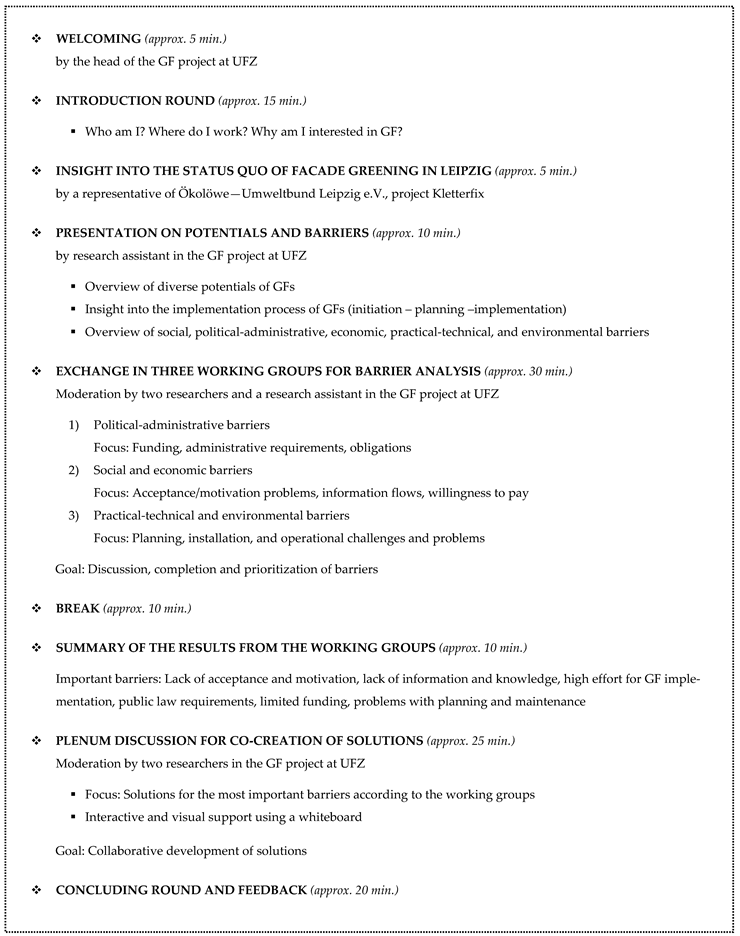
Appendix E
| No. | Domain | Institution/Position |
|---|---|---|
| 1 | Housing cooperative | Leipziger Wohnungs- und Baugesellschaft (LWB); experience with GF implementation on own buildings |
| 2 | Public Administration | City of Leipzig—Office for Building Regulations and Preservation of Historical Monuments; work in construction consultancy |
| 3 | Professional | Fassadengrün e.K. (distribution of GF elements) |
| 4 | Professional | Ökolöwe, Kletterfix project (educational and advisory service for GF); certified GF counsellor |
| 5 | Professional | Vertiko GmbH (advisory, planning, installation, and maintenance service for GF); GF consultant |
| 6 | Scientific Expert | Helmholtz Centre for Environmental Research (UFZ), GF project; special expertise: micrometeorological modeling and microclimatic measurements on GF |
Appendix F
- (1)
- Thematic Introduction, i.e., personal and occupational background and connection to GF, expert opinion on GF implementation barriers
- a.
- Why are you interested in GFs?
- b.
- Which experience/expertise do you have in the field of GFs? OR Where do you see occupational connecting factors to GFs?
- c.
- Which GF implementation barrier(s) do you consider particularly important?
- (2)
- Questions on specific GF implementation barriers identified in the literature review and the stakeholder workshop for critical evaluation based on the interviewees’ experience and expertise
- (3)
- Addressing the identified solutions paths and questions on specific measures developed in the stakeholder workshop for critical evaluation and further refinement based on the interviewees’ experience and expertise
- (4)
- Complementation of the measures already identified
- a.
- Which additional measures can be taken to reduce present barriers and to promote (successful) implementation of GFs?
Appendix G
| Solution Paths | Primarily Addressed Barriers | ||||||||||||||||||||||||
|---|---|---|---|---|---|---|---|---|---|---|---|---|---|---|---|---|---|---|---|---|---|---|---|---|---|
Three solution paths, each defined by a set of measures, were developed to overcome present GF implementation barriers:
| I (social) | II (pol.-adm.) | III (econ.) | IV (prac.-tech.|env.) | |||||||||||||||||||||
| i | ii | iii | iv | v | vi | i | ii | iii | iv | v | i | ii | iii | iv | i | ii | iii | iv | v | vi | vii | viii | ix | ||
| Lack of acceptance and motivation | Lack of information | Lack of awareness or knowledge | Uncertainties, concerns and prejudices | Insufficient communication and teamwork among actors | Subjective perception of aesthetics | Lack of ambition in politics and administration | Insufficient strategies and regulations | Insufficient incentives and support | Complex requirements and extensive procedures | Lack of uniform standards | Lack of means or willingness to pay | Acquisition cost | Operating cost | Insufficient return on investment | Unsuccessful practical- technical execution | Site and facade conditions | Extreme weather and climate change | Unwanted or harmful flora and fauna | Lack of data, models, information and guidelines | Lack of expertise and experience | Inconsistent or improper planning and installation | Maintenance problems | Negative environmental balance | ||
| (A.1) | Informative incentives (Scientific research, strengthening of information flows, guiding principle, transfer and public relations work, best practice examples) | × | × | × | × | × | × | ||||||||||||||||||
| (A.2) | Regulatory incentives (Recognition of GF as a compensation measure as per the German Conservation Act, rating systems and labelling programs for green buildings) | × | × | × | × | ||||||||||||||||||||
| (A.3) | Financial incentives (Funding programs, tax relief, subsidies for research and development in the field of GF) | × | × | × | × | × | |||||||||||||||||||
| (B.1) | Establishment of strategies and regulations (Consideration within well-founded policy strategies, enforcement of binding regulations) | × | × | × | × | × | |||||||||||||||||||
| (B.2) | Simplification of requirements and procedures (For installation, care, and maintenance of GFs) | × | × | × | × | × | |||||||||||||||||||
| (C.1) | Information on the implementation process (Provision of information on the practical process and the technical execution of GFs in low-threshold formats) | × | × | × | × | × | |||||||||||||||||||
| (C.2) | Support of the process through experts (Further education of experts on GFs, advisory services, active support in the implementation process) | × | × | × | × | × | × | × | |||||||||||||||||
| (C.3) | Contractually bundled maintenance offer (Public or private service providers, qualified personnel, service and maintenance contract throughout the whole lifespan of the GF) | × | × | × | |||||||||||||||||||||
References
- Andrić, I.; Koc, M.; Al-Ghamdi, S.G. A review of climate change implications for built environment: Impacts, mitigation measures and associated challenges in developed and developing countries. J. Clean. Prod. 2019, 211, 83–102. [Google Scholar] [CrossRef]
- United Nations. Sustainable Development Goals. Available online: https://www.un.org/sustainabledevelopment/cities/ (accessed on 5 May 2021).
- Revi, A.; Satterthwaite, D.; Aragón-Durand, F.; Corfee-Morlot, J.; Kiunsi, R.; Pelling, M.; Roberts, D.; Solecki, W.; Pahwa Gajjar, S.; Sverdlik, A. Urban areas. In Climate Change 2014: Impacts, Adaptation, and Vulnerability. Part A: Global and Sectoral Aspects. Contribution of Working Group II to the Fifth Assessment Report of the Intergovernmental Panel on Climate Change; IPCC, Ed.; Cambridge University Press: Cambridge, UK; New York, NY, USA, 2014; pp. 535–612. [Google Scholar]
- Henninger, S.; Weber, S. Stadtklima; utb: Paderborn, Germany, 2019; ISBN 9783825248499. [Google Scholar]
- Intergovernmental Panel on Climate Change. Climate Change 2014: Synthesis Report. Contribution of Working Groups I, II and III to the Fifth Assessment Report of the Intergovernmental Panel on Climate Change; Intergovernmental Panel on Climate Change: Geneva, Switzerland, 2014. [Google Scholar]
- Meili, N.; Manoli, G.; Burlando, P.; Bou-Zeid, E.; Chow, W.T.L.; Coutts, A.M.; Daly, E.; Nice, K.A.; Roth, M.; Tapper, N.J.; et al. An urban ecohydrological model to quantify the effect of vegetation on urban climate and hydrology (UT&C v1.0). Geosci. Model Dev. 2020, 13, 335–362. [Google Scholar] [CrossRef]
- Douglas, A.N.; Morgan, A.L.; Rogers, E.I.; Irga, P.J.; Torpy, F.R. Evaluating and comparing the green wall retrofit suitability across major Australian cities. J. Environ. Manag. 2021, 298, 113417. [Google Scholar] [CrossRef] [PubMed]
- Oberti, I.; Plantamura, F. Greenery Systems for Urban Sustainability: State of the Art and Perspective in Italy. WIT Trans. Built Environ. 2018, 179, 113–121. [Google Scholar]
- Hong, W.-T.; Ibrahim, K.; Loo, S.-C. Urging Green Retrofits of Building Façades in the Tropics: A Review and Research Agenda. Int. J. Technol. 2019, 10, 1140–1149. [Google Scholar] [CrossRef]
- Sprondel, N.; Donner, J.; Mahlkow, N.; Köppel, J. Urban climate and heat stress: How likely is the implementation of adaptation measures in mid-latitude cities? The case of façade greening analyzed with Bayesian networks. One Ecosyst. 2016, 1, e9280. [Google Scholar] [CrossRef]
- Mann, G.; Gohlke, R.; Wolff, F. BuGG-Marktreport Gebäudegrün 2020; Dach-, Fassaden-und Innenraumbegrünung Deutschland: Berlin, Germany, 2020. [Google Scholar]
- Mohandes, S.R.; Mahdiyar, A.; Sadeghi, H.; Tabatabaee, S.; Hosseini, M.R. Hindrances to the adoption of green walls: A hybrid fuzzy-based approach. In Proceedings of the International Conference of Architectural Science Association, Auckland, New Zealand, 26–27 November 2020; pp. 541–550. [Google Scholar]
- Biesbroek, G.R.; Klostermann, J.E.; Termeer, C.J.; Kabat, P. On the nature of barriers to climate change adaptation. Reg. Environ. Chang. 2013, 13, 1119–1129. [Google Scholar] [CrossRef]
- Lehmann, P.; Brenck, M.; Gebhardt, O.; Schaller, S.; Süßbauer, E. Barriers and opportunities for urban adaptation planning: Analytical framework and evidence from cities in Latin America and Germany. Mitig. Adapt Strateg. Glob. Chang. 2015, 20, 75–97. [Google Scholar] [CrossRef]
- Chan, A.P.C.; Darko, A.; Ameyaw, E.E. Strategies for Promoting Green Building Technologies Adoption in the Construction Industry—An International Study. Sustainability 2017, 9, 969. [Google Scholar] [CrossRef]
- Wong, N.H.; Tan, A.Y.K.; Tan, P.Y.; Sia, A.; Wong, N.C. Perception Studies of Vertical Greenery Systems in Singapore. J. Urban Plan. Dev. 2010, 136, 330–338. [Google Scholar] [CrossRef]
- Palermo, S.; Turco, M. Green Wall Systems: Where do we Stand? In IOP Conference Series: Earth and Environmental Science; IOP Publishing: Bristol, UK, 2020; Volume 410. [Google Scholar] [CrossRef]
- Perini, K. Greening the Building Envelope. In Bioclimatic Approaches in Urban and Building Design; Chiesa, G., Ed.; Springer Nature AG: Cham, Switzerland, 2021; pp. 401–414. ISBN 978-3-030-59328-5. [Google Scholar]
- Francis, R.A.; Lorimer, J. Urban reconciliation ecology: The potential of living roofs and walls. J. Environ. Manag. 2011, 92, 1429–1437. [Google Scholar] [CrossRef]
- Iligan, R.; Irga, P. Are green wall technologies suitable for major transport infrastructure construction projects? Urban For. Urban Green. 2021, 65, 127313. [Google Scholar] [CrossRef]
- Kaltschmitt, M.; Streicher, W.; Wiese, A. Erneuerbare Energien—Systemtechnik, Wirtschaftlichkeit, Umweltaspekte, 6th ed.; Springer Vieweg: Berlin/Heidelberg, Germany, 2020; ISBN 978-3-662-61189-0. [Google Scholar]
- Leong, B.T.; Yeap, P.S.; Ang, F.L. The initial study on implementation of vertical greenery in Malaysia. In IOP Conference Series: Earth and Environmental Science; IOP Publishing: Bristol, UK, 2021; Volume 685, p. 12017. [Google Scholar] [CrossRef]
- Price, A.; Jones, E.C.; Jefferson, F. Vertical Greenery Systems as a Strategy in Urban Heat Island Mitigation. Water Air Soil Pollut. 2015, 226, 1–11. [Google Scholar] [CrossRef]
- Marchi, M.; Pulselli, R.M.; Marchettini, N.; Pulselli, F.M.; Bastianoni, S. Carbon dioxide sequestration model of a vertical greenery system. Ecol. Model. 2015, 306, 46–56. [Google Scholar] [CrossRef]
- Pérez, G.; Coma, J.; Sol, S.; Cabeza, L.F. Green facade for energy savings in buildings: The influence of leaf area index and facade orientation on the shadow effect. Appl. Energy 2017, 187, 424–437. [Google Scholar] [CrossRef]
- Coma, J.; Pérez, G.; de Gracia, A.; Burés, S.; Urrestarazu, M.; Cabeza, L.F. Vertical greenery systems for energy savings in buildings: A comparative study between green walls and green facades. Build. Environ. 2017, 111, 228–237. [Google Scholar] [CrossRef]
- Grinde, B.; Patil, G.G. Biophilia: Does visual contact with nature impact on health and well-being? Int. J. Environ. Res. Public Health 2009, 6, 2332–2343. [Google Scholar] [CrossRef] [PubMed]
- Mosgaard, M.; Maneschi, D. The energy renovation journey. Int. J. Innov. Sustain. Dev. 2016, 10, 177–197. [Google Scholar] [CrossRef]
- Lu, H.; Mayer, A.L.; Wellstead, A.M.; Zhou, S. Can the dual identity of policy entrepreneur and policy implementer promote successful policy adoption? Vertical greening policymaking in Shanghai, China. J. Asian Public Policy 2020, 13, 113–128. [Google Scholar] [CrossRef]
- Murphy, S.M.; Rayner, J.P.; Hall, G.; Francis, J. Growing green: Developing industry guidelines for green infrastructure. Acta Hortic. 2016, 1108, 291–296. [Google Scholar] [CrossRef]
- Wilkinson, S.; Carmichael, M.; Khonasty, R. Towards smart green wall maintenance and Wallbot technology. Prop. Manag. 2021, 39, 466–478. [Google Scholar] [CrossRef]
- Shamseer, L.; Moher, D.; Clarke, M.; Ghersi, D.; Liberati, A.; Petticrew, M.; Shekelle, P.; Stewart, L.A. Preferred reporting items for systematic review and meta-analysis protocols (PRISMA-P) 2015: Elaboration and explanation. BMJ 2015, 350, g7647. [Google Scholar] [CrossRef] [PubMed]
- Artmann, M.; Sartison, K. The Role of Urban Agriculture as a Nature-Based Solution: A Review for Developing a Systemic Assessment Framework. Sustainability 2018, 10, 1937. [Google Scholar] [CrossRef]
- Kusay-Merkle, U. Agiles Projektmanagement im Berufsalltag—Für Mittlere und Kleine Projekte: Die Gestaltung von Meetings und Workshops; Springer Gabler: Heidelberg, Germany, 2018; ISBN 978-3-662-56800-2. [Google Scholar]
- Henseling, C.; Hahn, T.; Nolting, K. Fokusgruppen-Methode als Instrument in der Umwelt-und Nachhaltigkeitsforschung; Institut für Zukunftsstudien und Technologiebewertung (IZT): Berlin, Germany, 2006. [Google Scholar]
- Gläser, J.; Laudel, G. Experteninterviews und Qualitative Inhaltsanalyse als Instrumente Rekonstruierender Untersuchungen, 3rd ed.; VS Verlag für Sozialwissenschaften: Wiesbaden, Germany, 2009; ISBN 978-3531156842. [Google Scholar]
- Kaiser, R. Qualitative Experteninterviews. In Konzeptionelle Grundlagen und Praktische Durchführung, 2nd ed.; Springer VS: Siegen, Germany, 2021; ISBN 978-3-658-02479-6. [Google Scholar]
- Henseke, A.; Breuste, J.H. Climate-Change Sensitive Residential Areas and Their Adaptation Capacities by Urban Green Changes: Case Study of Linz, Austria. J. Urban Plan. Dev. 2015, 141, A5014007. [Google Scholar] [CrossRef]
- Zinia, N.J.; McShane, P. Ecosystem services management: An evaluation of green adaptations for urban development in Dhaka, Bangladesh. Landsc. Urban Plan. 2018, 173, 23–32. [Google Scholar] [CrossRef]
- Magliocco, A. Vertical Greening Systems. In Nature Based Strategies for Urban and Building Sustainability; Pérez, G., Perini, K., Eds.; Elsevier: Amsterdam, The Netherlands, 2018; pp. 263–271. ISBN 978-0-12-812150-4. [Google Scholar]
- Conejos, S.; Chew, M.Y.L.; Azril, F.H.B. Green maintainability assessment of high-rise vertical greenery systems. Facilities 2019, 37, 1008–1047. [Google Scholar] [CrossRef]
- Rek-Lipczynska, A. Purification of the Air in the Historic Cities of Towns. In IOP Conference Series: Earth and Environmental Science; IOP Publishing: Bristol, UK, 2019; Volume 471, p. 102029. [Google Scholar] [CrossRef]
- Ascione, F.; de Masi, R.F.; Mastellone, M.; Ruggiero, S.; Vanoli, G.P. Green Walls, a Critical Review: Knowledge Gaps, Design Parameters, Thermal Performances and Multi-Criteria Design Approaches. Energies 2020, 13, 2296. [Google Scholar] [CrossRef]
- Carmichael, M.; Khonasty, R.; Wilkinson, S.; Schork, T. The Wallbot: A Low-cost Robot for Green Wall Inspection. In Australasian Conference on Robotics and Automation; ACRA: Singapore, 2020. [Google Scholar]
- Adegun, O.B.; Ikudayisi, A.E.; Morakinyo, T.E.; Olusoga, O.O. Urban green infrastructure in Nigeria: A review. Sci. Afr. 2021, 14, e01044. [Google Scholar] [CrossRef]
- Bundesverband GebäudeGrün, E.V.; German Federal Association for Green Buildings. BuGG-Seminarübersicht zur Fort- und Weiterbildung Gebäudebegrünung. 2022. Available online: https://www.gebaeudegruen.info/aktuelles/seminare-veranstaltungen-messen/bugg-veranstaltungen/fortbildung (accessed on 1 June 2023).
- Karutz, R.; Zozmann, H.; Wollschläger, N.; Schlink, U. Fassadenbegrünung als multifunktionales Anpassungsinstrument gegen Hitze: Ergebnisse des Leipziger Pilotprojekts „Lebendige Wände“. In Die resiliente Stadt: Konzepte, Konflikte, Lösungen; Kabisch, S., Rink, D., Banzhaf, E., Eds.; Springer Spektrum: Heidelberg, Germany, 2023; in press. [Google Scholar]
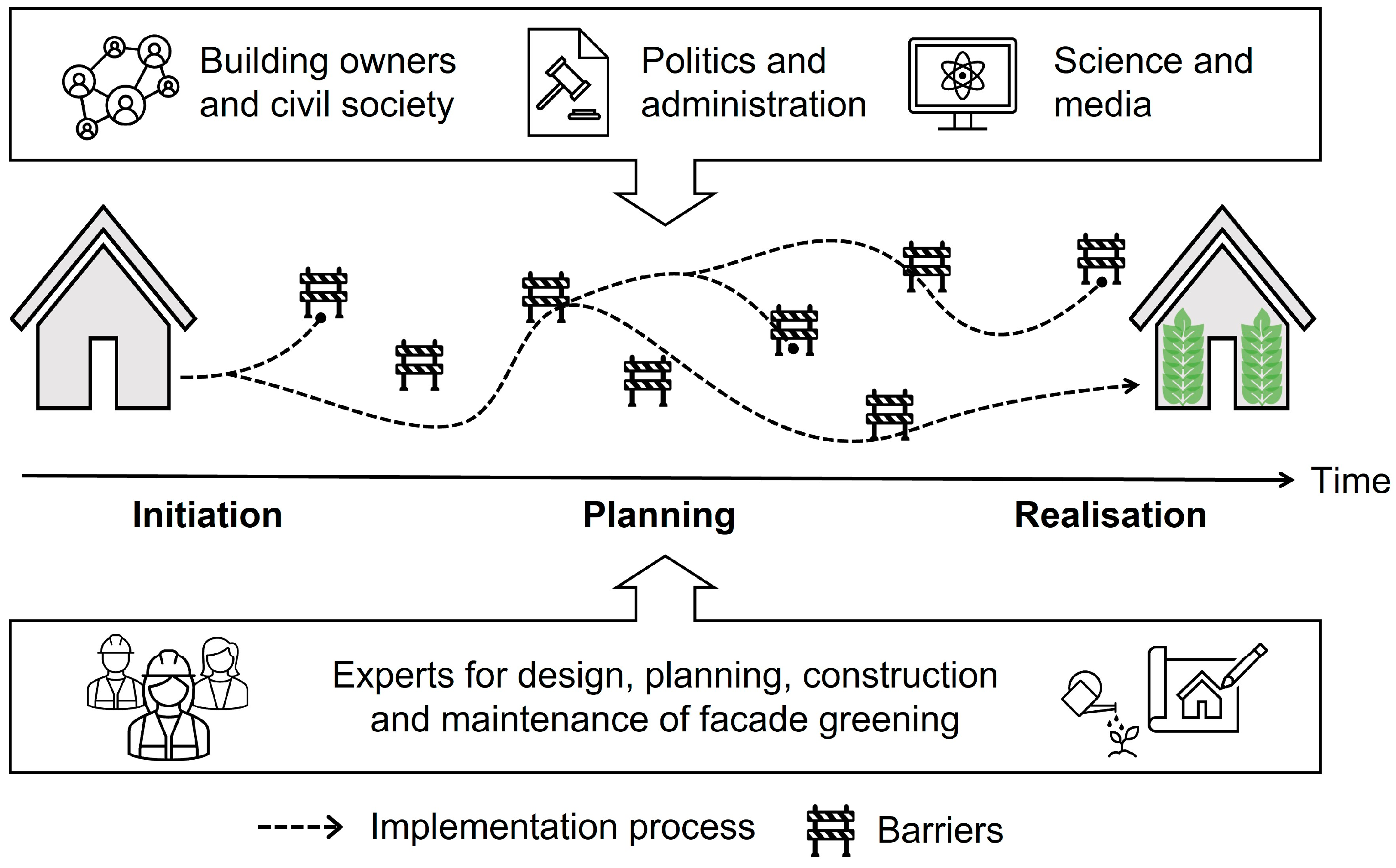
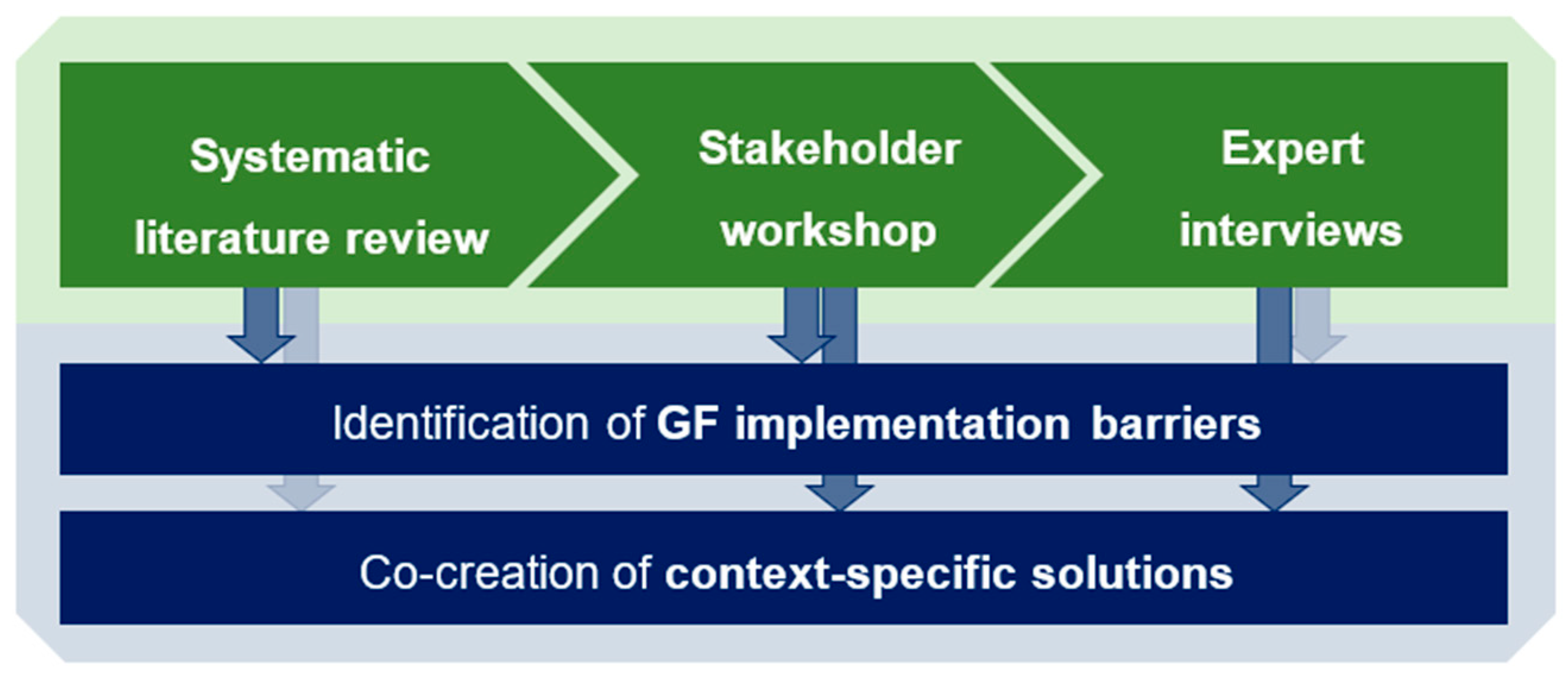
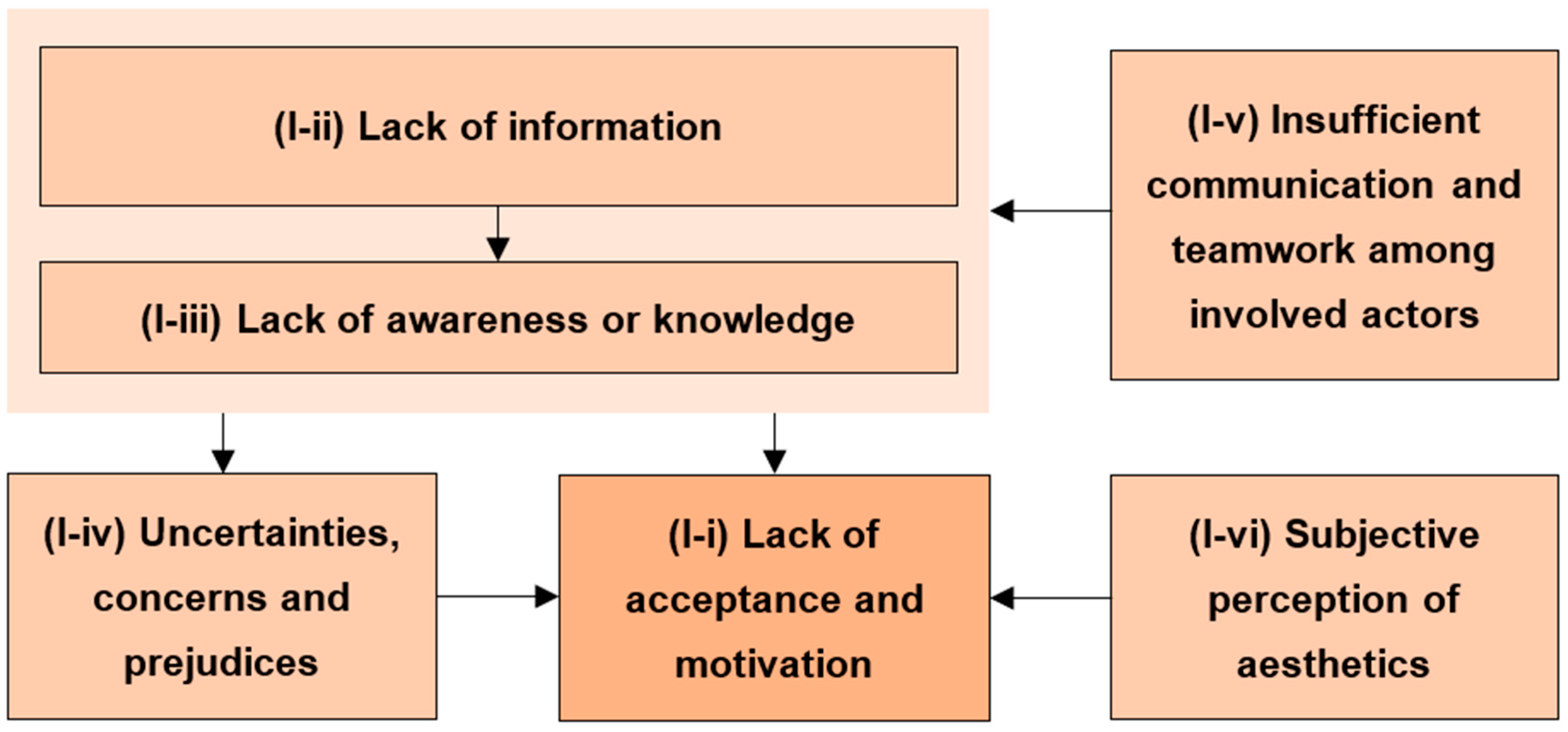
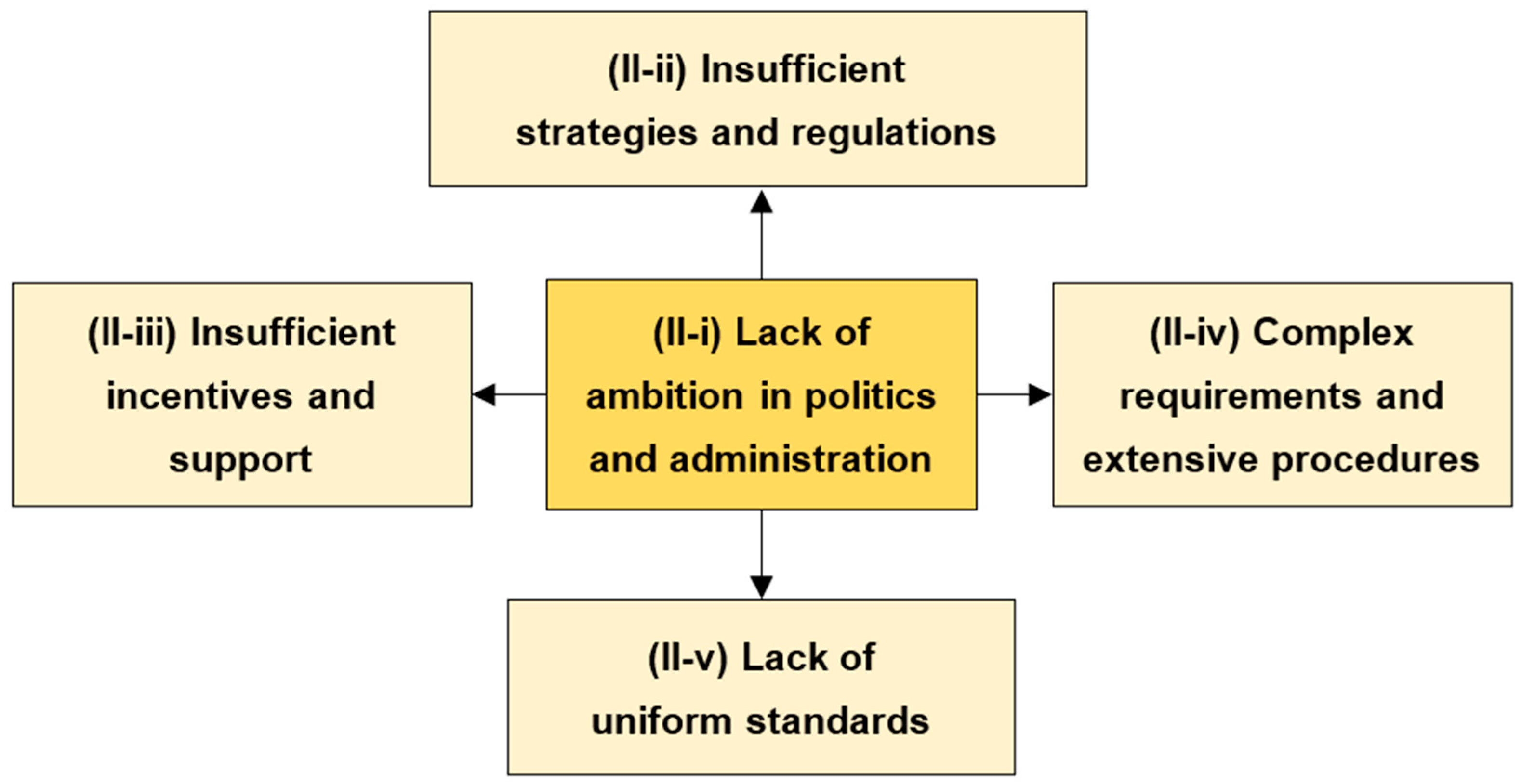
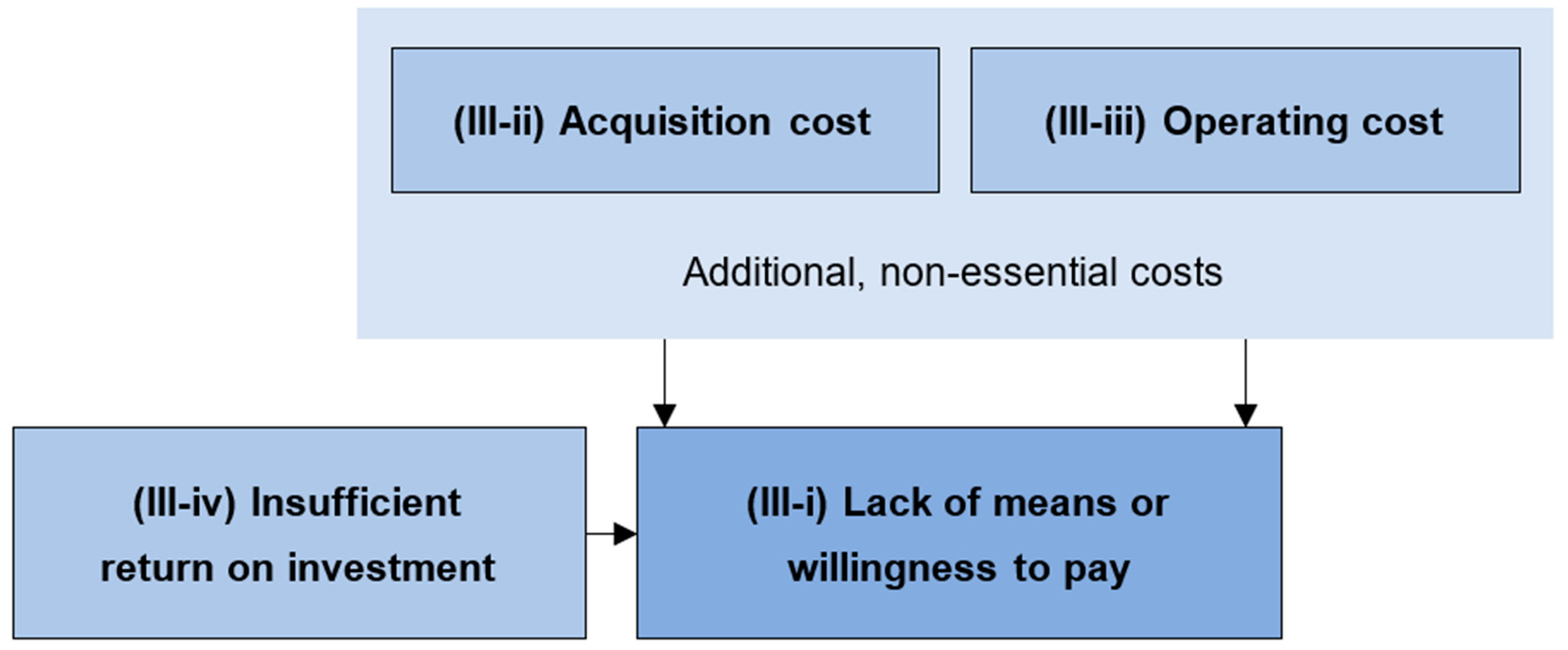
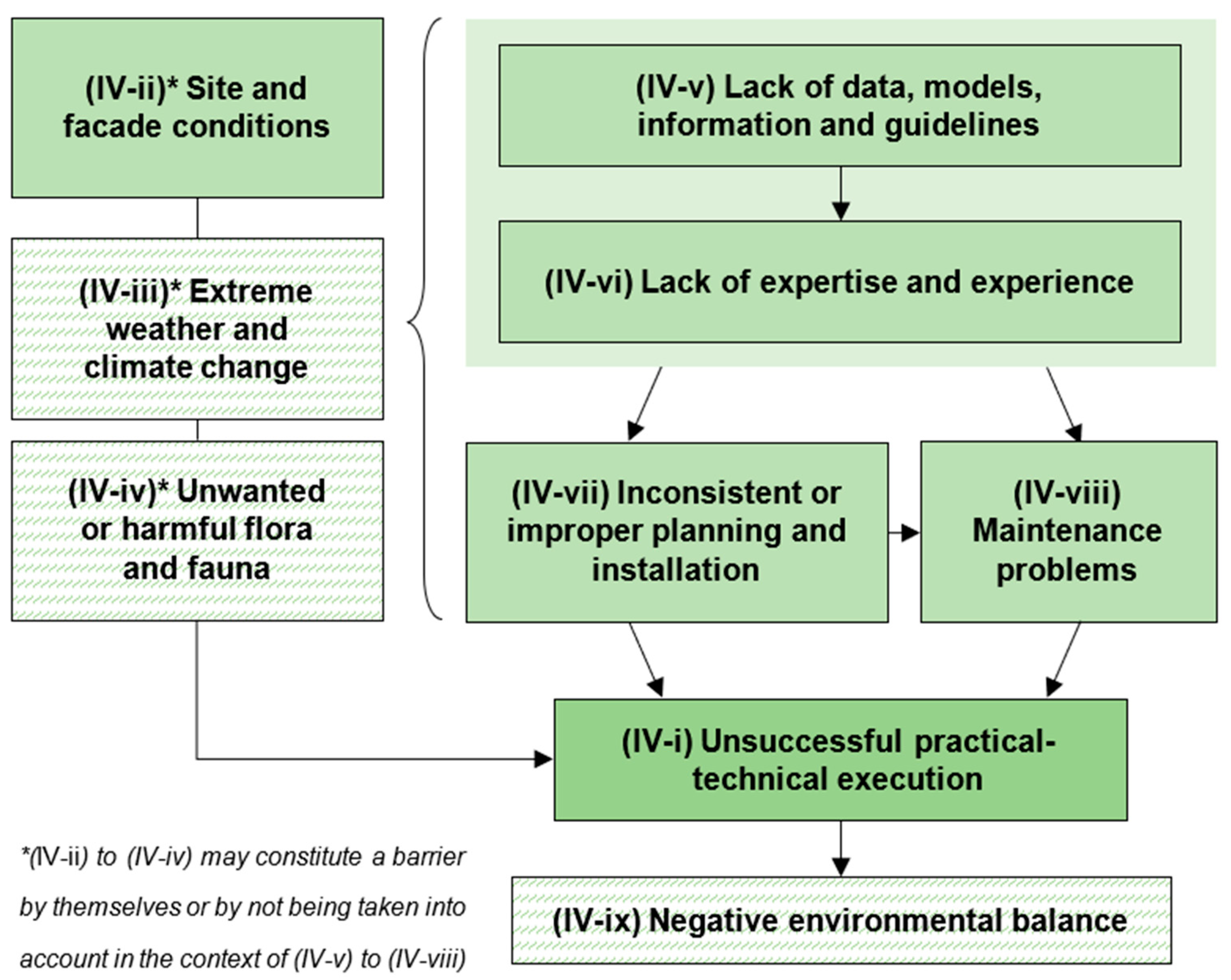
Disclaimer/Publisher’s Note: The statements, opinions and data contained in all publications are solely those of the individual author(s) and contributor(s) and not of MDPI and/or the editor(s). MDPI and/or the editor(s) disclaim responsibility for any injury to people or property resulting from any ideas, methods, instructions or products referred to in the content. |
© 2023 by the authors. Licensee MDPI, Basel, Switzerland. This article is an open access article distributed under the terms and conditions of the Creative Commons Attribution (CC BY) license (https://creativecommons.org/licenses/by/4.0/).
Share and Cite
Knifka, W.; Karutz, R.; Zozmann, H. Barriers and Solutions to Green Facade Implementation—A Review of Literature and a Case Study of Leipzig, Germany. Buildings 2023, 13, 1621. https://doi.org/10.3390/buildings13071621
Knifka W, Karutz R, Zozmann H. Barriers and Solutions to Green Facade Implementation—A Review of Literature and a Case Study of Leipzig, Germany. Buildings. 2023; 13(7):1621. https://doi.org/10.3390/buildings13071621
Chicago/Turabian StyleKnifka, Wiebke, Raphael Karutz, and Heinrich Zozmann. 2023. "Barriers and Solutions to Green Facade Implementation—A Review of Literature and a Case Study of Leipzig, Germany" Buildings 13, no. 7: 1621. https://doi.org/10.3390/buildings13071621
APA StyleKnifka, W., Karutz, R., & Zozmann, H. (2023). Barriers and Solutions to Green Facade Implementation—A Review of Literature and a Case Study of Leipzig, Germany. Buildings, 13(7), 1621. https://doi.org/10.3390/buildings13071621






